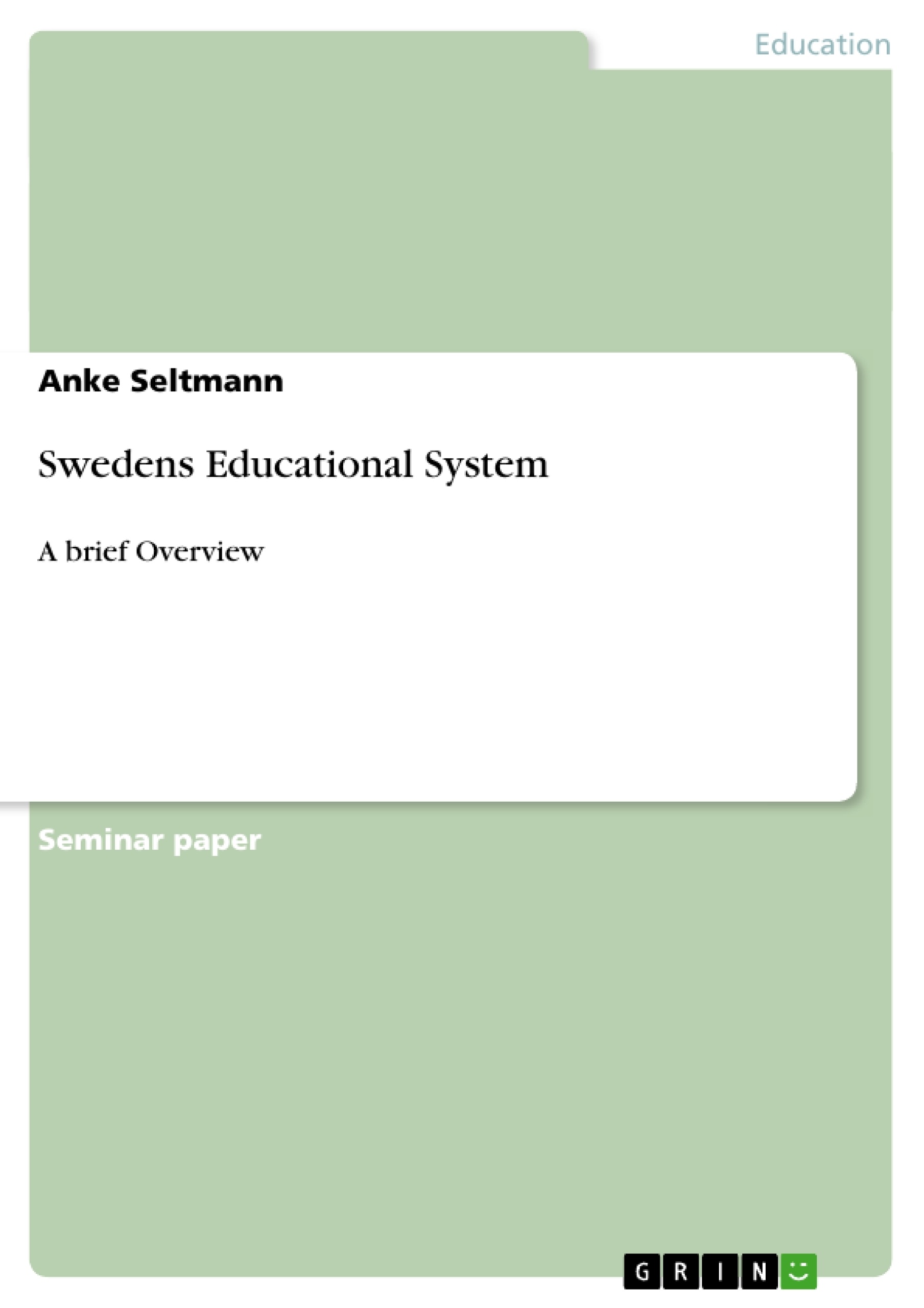Introduction
Sweden is the third largest country in the European Union after France and Spain. It has approximately 9 million inhabitants thereof ca. 1 million immigrants . Till the end of August 2006 there had 64,681 Immigrants been given excess to Sweden. So the population is heterogeneous and is concentrated in mainly three areas of the country.
“In an international comparison, the Swedish overall rate of participation in education is one of the highest.” The basic principle of education in Sweden is equality. This means equality of opportunities / access but also equality of outcomes / results. Everybody in Sweden must have access to an equivalent, uniform education, regardless of sex, irrespective of their social or ethnic backgrounds or their place of residence, because a well-educated society is a prerequisite for the expansion of the country’s economic and the further development of the Swedish welfare state. There is also a big awareness of the importance of research and development. Due to this the cost for the education system in Sweden are very high, among the highest in the world .
In the following pages I want to outline the Swedish educational system. I will start with a sketch of the reforms and according to the lights of this essay I will begin with the 20th century. The goal is to shed light on the needs of the society and on political reasons of the reforms. Furthermore I will represent an overview of the today’s system and discuss the differences between the “old” and the “new” strategies as well as advantages and disadvantages.
The History of Sweden’s Education – short Review
In the 19th century Sweden rapidly transformed from an agricultural, traditional society into an industrialised society. During this industrialisation and also democratisation the well-known Swedish model developed (1920s). By this is the specific model of a social welfare system is meant. It was characterized by centralism, universalism and cooperation between the capital and labour (consensus). At that time the focus was on developing a (social) welfare system this includes also focus on the education system. In this inclusive and centralised welfare state, science was a tool for modernising society in large reforms. The peak was reached in the 1970s. During this decade the demands for decentralisation as well as pluralism increased.
[...]
Table of Contents
- Introduction
- The History of Sweden's Education – short Review
- Pre-school Education
- Compulsory School
- Upper secondary school
- Higher Education
- Adult Education
- Financing
- Discussion & Review
Objectives and Key Themes
This paper provides an overview of Sweden's educational system, focusing on its historical development, current structure, and key principles. The paper explores the evolution of the system, highlighting significant reforms and their motivations. It also examines the contemporary system, discussing the similarities and differences between older and newer approaches, as well as advantages and disadvantages.- Historical development of the Swedish education system
- Evolution of reforms and their underlying motivations
- Structure and characteristics of the contemporary educational system
- Comparison between traditional and modern approaches
- Strengths and weaknesses of the current educational system
Chapter Summaries
- Introduction: This chapter sets the stage for the paper by introducing Sweden's demographics and highlighting the importance of education for its economic and social development. It emphasizes the principle of equality in access and outcomes, as well as the high costs associated with the Swedish education system. The author outlines the structure of the paper, focusing on the 20th century and beyond.
- The History of Sweden's Education – short Review: This chapter traces the evolution of Sweden's education system from the 19th century, highlighting the shift from an agricultural to an industrialized society. It discusses the development of the Swedish social welfare model, emphasizing its focus on education. The chapter discusses the significant reforms of the 1970s and 1980s, which led to the decentralization of the system.
- Pre-school Education: This chapter delves into the history of preschool education in Sweden, starting from the first infant crèche in 1854. The chapter discusses the increasing demand for state-funded childcare in the 1930s-1940s and the rise of the preschool system. The chapter details the implementation of free attendance for children aged six and older in 1975 and examines the subsequent reforms that aimed to streamline the system. The chapter concludes by highlighting the "edu-care" approach that integrates care, education, and services in the Swedish preschool model.
- Compulsory School: This chapter provides an overview of the compulsory education system in Sweden, which mandates schooling for all children between the ages of 7 and 16. The chapter discusses the historical background of compulsory education, highlighting the significant time it took to make elementary education accessible to everyone. The chapter emphasizes the aim of providing equal education opportunities regardless of gender, ethnicity, social background, or place of residence. Finally, the chapter outlines the key components of the compulsory school system, including Sami school, special schools, and schools for children with learning disabilities.
Keywords
This paper examines the Swedish educational system, focusing on its historical development, key principles, and current structure. It explores the significance of education for Sweden's economic and social development, highlighting the emphasis on equality, accessibility, and quality. The paper delves into important reforms and their motivations, examining the transition from a centralized to a decentralized system. It also considers the evolution of the preschool system and the emergence of the "edu-care" approach. Keywords include: Swedish education system, equality, accessibility, reforms, social welfare model, decentralization, preschool education, edu-care, compulsory education.- Quote paper
- Anke Seltmann (Author), 2006, Swedens Educational System, Munich, GRIN Verlag, https://www.grin.com/document/131326




